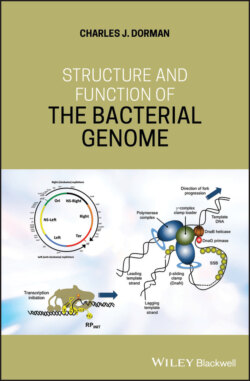Читать книгу Structure and Function of the Bacterial Genome - Charles J. Dorman - Страница 41
1.30 DNA Topoisomerases: DNA Topoisomerase I
ОглавлениеThe principal source of relaxation activity for negatively supercoiled DNA is Topo I, a monomeric, ATP‐independent enzyme that is encoded by the topA gene in the Ter macrodomain (Margolin et al. 1985) (Table 1.1). This enzyme also has a catenase/decatenase activity on double‐stranded circular DNA with single‐stranded regions (Terekhova et al. 2012; Tse and Wang 1980) and prevents over‐replication of the chromosome originating at oriC (Usongo and Drolet 2014). Topo I is a type I topoisomerase that has a ‘swivelase’ activity. It cuts one of the two DNA strands in a negatively supercoiled molecule, forming a covalent link to the cut strand, and allows the torsional strain in the DNA to drive the rotation of the intact strand through the gap (Kirkegaard and Wang 1978). The result is an increase of 1 in the linking number of the DNA (Bates and Maxwell 2005). The topA gene is not essential, although knockout mutants grow slowly (Margolin et al. 1985; Sternglanz et al. 1981). Bacteria that lose Topo I through topA knockout mutations can compensate in different ways, restoring a growth rate that is close to that of wild‐type strains (Raji et al. 1985; Richardson et al. 1984). One option is to acquire non‐lethal mutations in gyrA or gyrB that result in the expression of a gyrase with a reduced negative supercoiling activity (DiNardo et al. 1982; Pruss and Drlica 1985; Pruss et al. 1982, 1986; Richardson et al. 1984, 1988). Another possibility exploits the amplification of the copy number of the parC and parE genes, resulting in increased expression of Topo IV. In these strains the elevated expression of Topo IV with its DNA‐relaxing activity can compensate for the missing Topo I, restoring the growth rate of the mutant to one that is similar to wild type (Dorman et al. 1989; Free and Dorman 1994; McNairn et al. 1995). Bacteria that are not exposed to stressful growth conditions such as elevated temperature, low pH, or raised osmotic stress or lack of oxygen do not require compensatory mutations in order to display normal rates of growth (Ní Bhriain and Dorman 1993). This suggests that a link exists between environmental stress and the management of DNA supercoiling in bacteria (Dorman and Dorman 2016).
